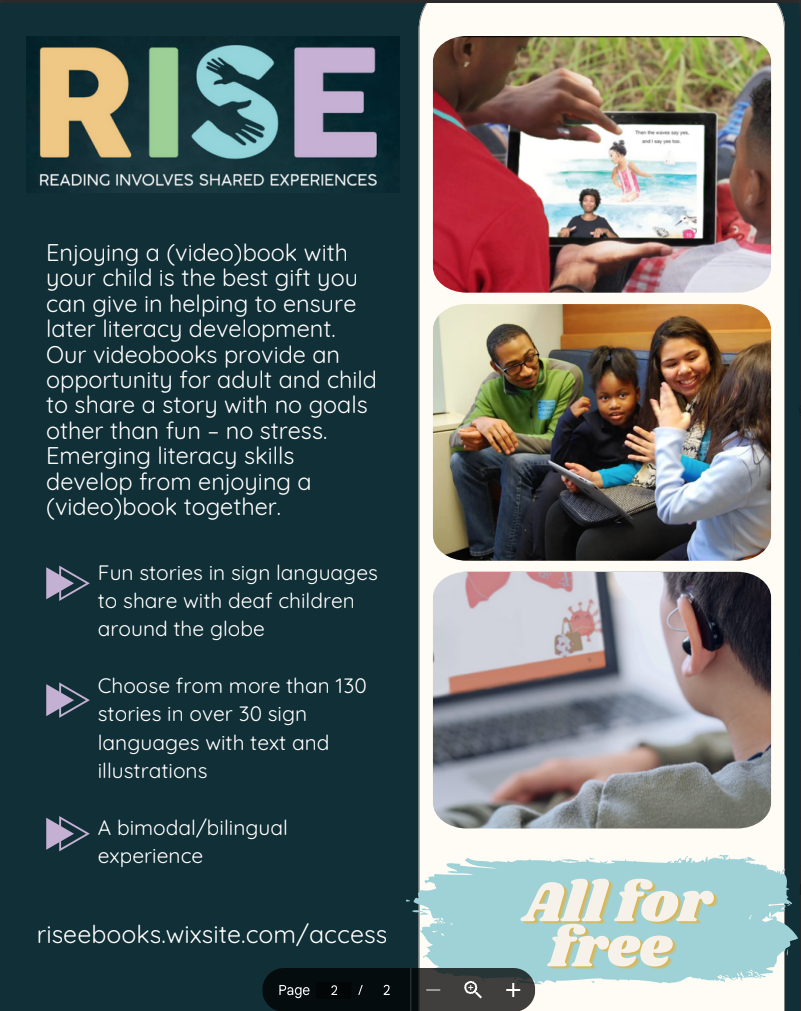PLAY Lab Resources
- RIT/
- Perception, Language and Attention in Youth (PLAY) Lab
Welcome to the NTID PLAY Lab Resource Center!
Resources for Parents
The resources listed here are meant to provide awareness for families with Deaf/Hard-of-Hearing children to enhance brain development and growth.
Rise Books has a variety of books in 33 different sign languages from different countries. Rise Books promotes emergent literacy skills (preliteracy skills) via promoting shared reading activities.
https://riseebooks.wixsite.com/access/countries

[ID: The word “RISE” on the top with hands in the “S.” Text: Reading Involves Shared Experiences. Enjoying a (video)book with your child is the best gift you can give in helping to ensure later literacy development. Our videobooks provide an opportunity for adult and child to share a story with no goals other than fun—no stress. Emerging lliteracy skills develop from enjoying a (video) book together.
Text: Fun stories in sign languages to share with deaf children around the globe.
Text: Choose from more than 130 stories in over 30 sign languages with text and illustrations
Text: A bimodal/bilingual experience
Website: riseebooks.wixsite.com/access
Photos on right: Top: A person with dark skin poingint to a laptop screen next to a child with dark skin.
Middle: Four people with dark skin sitting on a couch. One is holding a laptop next to a child with a raised hand.
Bottom: a young person with dark short hair wearing a hearing aid with a laptop in front of them.
Bottom text: All for free]
A majority of Deaf children across the world are experiencing a lack of literacy resources. Due to a shortage of adults proficient in native sign languages, Deaf children are unable to access stories during a critical period of their language and cognitive development. This is the problem World Around You aims to solve.
World Around You is an open source, web-based authoring platform that allows for the creation and distribution of multilingual signed stories with written text across the Internet. Contributors combine images, text, and videos of signing storytellers to create web-based visual storybooks featuring local, regional, and national sign languages. The platform also provides classroom management features so teachers can use it to educate their students.
https://deafworldaroundyou.org/Stories (Signed Stories)
Every child loves, and deserves, a great story. Great stories invite children into our vast world, encouraging new ways to imagine and then leading them down the path to reading and learning.
We love stories. And we love sharing great stories—especially now that we have this new form of visual storytelling in ASL and English!
Download a PDF of the following PLAY Lab Resources for Parents.
PLAY Tips:

Brainy Facts:
(Follow us on Twitter at @NTIDPLAYLab on Brainy Fridays!)
Your brain is your body’s “Command Center.” All of your thoughts and body actions are powered by your brain.
Humans are the most sophisticated beings on planet earth when it comes to the ability to communicate with one another.
The average brain weighs approximately three pounds. A newborn baby’s brain is about 3/4ths of one pound. (Source: verywellmind.com)
Your brain’s storage capacity is considered virtually unlimited. (Source: Northwestern Medicine)
A human brain contains roughly 86 billion nerve cells, or neurons. (Source: Brainfacts.org)

More Brain Facts
- The brain contains at birth most of the neurons it will ever have.
- The brain is like a race car - it travels at 268 miles an hour!
- The brain is active, even when you are sleeping.
- The average brain weighs about 3 pounds.
Deaf/Hard of hearing babies have varying levels of hearing. Often in a young baby/child, what they can/cannot hear is a guessing game and can differ from situation to situation throughout the day.
Here are some ways to increase visual attention and engagement with your baby:
When walking with your baby in a stroller, stop in intervals and connect together. This process lets your baby know that you are there and provides opportunities to engage in the environment you are walking in. If you stop to talk with someone, position the stroller so that your baby can see you.
If you walk with your baby in a baby carrier in front of you, provide a soft touch to let them know you are there. Pull out a toy and show it to them to engage with them. Depending on your baby’s hearing level, they may not be able to hear your voice at all or it may sound distorted–keep this in mind when your baby is facing forward and unable to see you.
Babies love repetition and they learn when presented with something over and over.












